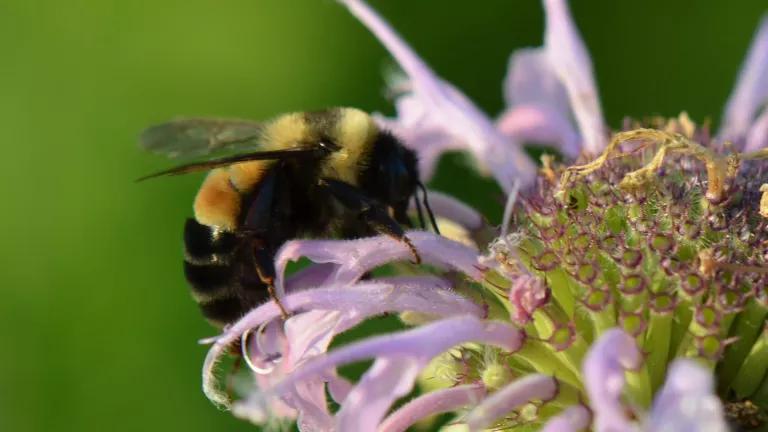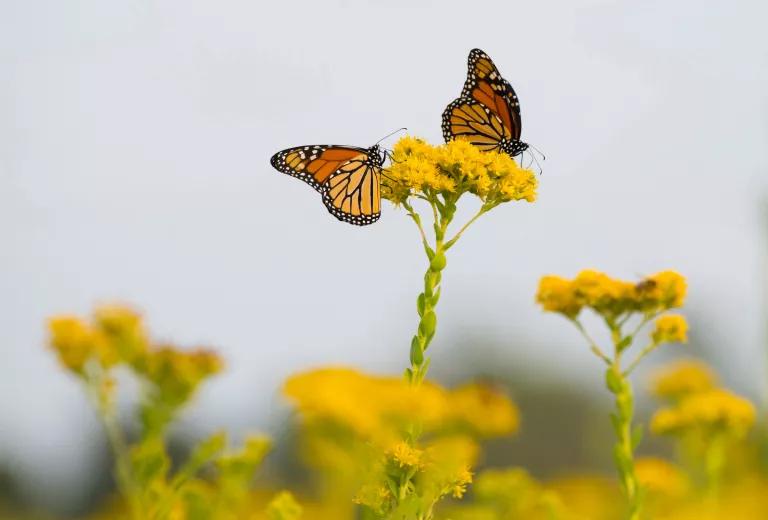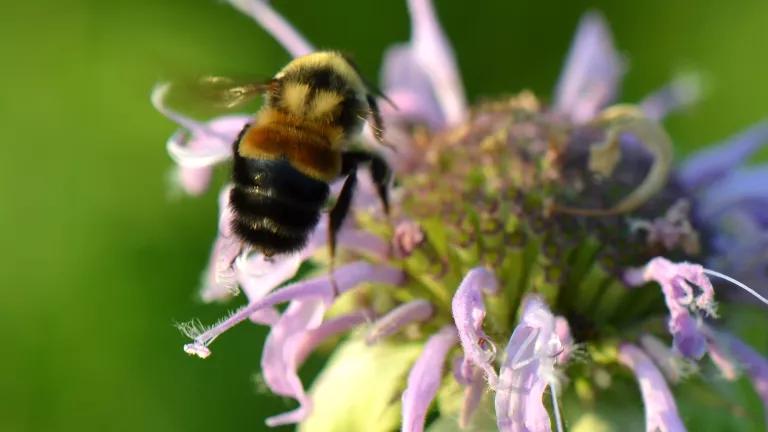Pristine Prairie, Home to Endangered Bee, May Be Destroyed
An airport expansion threatens to wipe out a population of the once-common, now endangered, rusty patched bumble bee. The U.S. Fish and Wildlife Service's failure to protect the bee's habitat is partly to blame.

The once-common rusty patched bumble bee is at grave risk of extinction.
Kim Mitchell/USFWS
UPDATE: As of October 28, 2021, just days before the Bell Bowl Prairie was slated for destruction, the Chicago Rockford International Airport has announced that it will pause construction. Before moving forward with any renovation, it will re-initiate consultation under the Endangered Species Act and other statutes to ensure that impacts on the rusty patched bumble bee and other species are taken into account.
As of today, the Bell Bowl Prairie—a small but extraordinarily rare vestige of “old-growth” prairie habitat in Rockford, Illinois—still provides safe haven for endangered rusty patched bumble bees. Unfortunately, due to a Trump-era U.S. Fish and Wildlife Service (Service) failure, this population may be without a home at the end of the month.
The Rusty Patched Bumble Bee and the Protections It Deserves
Once common throughout the Midwest and Northeast, the rusty patched bumble bee has disappeared from about 87% of its range since the mid-1990s. In 2017, the bee had the unfortunate honor of becoming the first bee in the continental United States to be listed as an endangered species, following a pair of lawsuits by NRDC to secure protections under the Endangered Species Act (ESA).
The ESA generally requires the Service to designate “critical habitat” for all listed species, defined essentially as areas that are important for the species’ survival and recovery. That habitat then receives important federal protection from actions that would destroy or “adversely modify” the area.
While critical habitat designation is a keystone element of the ESA, the Service under the Trump administration changed its regulations to attempt to make it easier for the agency to refuse to designate habitat for nearly any reason at all.

Much of the bee's historic prairie habitat has been converted to agricultural land.
An Imprudent Decision
And that’s exactly what the FWS did. In September of 2020, after a third NRDC lawsuit, it refused to designate “critical habitat” for the bee, finding that doing so would not be “prudent”—ignoring a mountain of evidence that habitat destruction has driven the bee’s decline, as well as its own previous conclusions that protecting and restoring habitat is key to the bee’s recovery.
In March of 2021, NRDC sued again.
Protecting the bee’s preferred grassland and prairie habitat makes a lot of sense—for the bee and for the many other species that call these areas home. About 99.9% of native grassland habitat in the U.S. has been destroyed since European settlement. But because the Service has not designated critical habitat, remaining areas of the bee’s habitat are without key federal safeguards.
Grave Consequences
The situation at Bell Bowl Prairie highlights the consequences of the Service’s decision. On November 1, 2021, an expansion of the Chicago Rockford International Airport is slated to completely eradicate the bee’s habitat there.
Bell Bowl is a rarity—a remnant of the original prairie and grassland habitat that once covered North America for millennia. Today, only scattered patches of this ecosystem remain, especially in the “Prairie State,” where .01 percent of historic prairie is still standing. Even rarer, Bell Bowl is a “gravel hill prairie,” of which, only about 148 acres remain in Illinois. Its pristine quality led the Illinois Department of Natural Resources to deem it a Category I Illinois Natural Inventory Site, indicating it is some of the highest quality prairie habitat remaining.

High-quality prairie provides prime habitat for a huge variety of wildlife, like monarch butterflies and other imperiled species.
Home to the rusty patched bumble bee—photographed there in August of 2021—Bell Bowl is also home to a host of rare and endangered plant species. It’s exactly the sort of habitat that could have been designated by the Service as critical habitat, which would have required the federal agencies involved take a harder look at how the project would impact the value of that habitat for the bee. This would be true regardless of whether they could spot the bee itself on the land—a tough task when searching for a tiny, rare insect.
In short, designation would have given the bee, and Bell Bowl, a fighting chance to survive by putting more pressure earlier on the relevant agencies and actors to consider alternatives to the short-sighted plan to bulldoze one of the few original vestiges of Illinois’s namesake ecosystem. That is why NRDC’s lawsuit, and critical habitat designation generally, is so important.
But even without critical habitat designation, this fight is not over yet. There is still time to save Bell Bowl Prairie from destruction. Click this link to see how you can join the fight.




